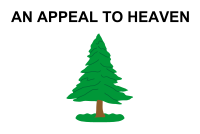Pine Tree Flag
 | |
| Use | Other |
|---|---|
| Proportion | 2:3 |
| Adopted | Used on American vessels by October 20, 1775;[1] formally adopted by the Massachusetts Council on April 29, 1776[2] |
| Design | A white field charged with a green pine tree, and the words "AN APPEAL TO HEAVEN" in capital letters above the tree. |
The Pine Tree Flag (or the An Appeal to Heaven Flag) was one of the flags used during the American Revolution. The flag, which featured a pine tree with the motto "An Appeal to Heaven", or less frequently "An Appeal to God", was used by a squadron of six schooners commissioned under George Washington's authority as commander-in-chief of the Continental Army beginning in October 1775.
The pine tree is a traditional symbol of New England. The phrase "appeal to heaven" appears in John Locke's Second Treatise on Government, where it is used to describe the right of revolution.
The flag is the official maritime ensign for the Commonwealth of Massachusetts, though the script was removed in 1971. It was used by state navy vessels in addition to privateers sailing from Massachusetts.[3]
Design and adoption



A flag with a pine tree on it, "a red flag with the cross of St. George in the canton with a green pine tree in the first quarter", was used in New England as early as 1704, and may have flown at Bunker Hill in 1775. It also appeared having a "white field with the motto 'An Appeal to Heaven' above the pine tree".[4]
In a letter dated October 20, 1775,[1][2] General Washington's secretary, Colonel Joseph Reed, suggested a "flag with a white ground and a tree in the middle, the motto AN APPEAL TO HEAVEN" be used for the ships Washington commissioned.[5] Two heavily armed American scows, or "floating batteries," launched on the Charles River in September 1775 had used the Pine Tree flag as an ensign; in his letter, Reed described the banner he proposed as "the flag of our floating batteries."[2][1] The six schooners commissioned by Congress beginning in October 1775 to intercept British ships entering Boston—the USS Hancock, Lee, Franklin, Harrison, Lynch, and Warren—used the Pine Tree flag.[2][1]
The following year, on April 29, 1776,[2][1] the Massachusetts Council established the flag of the state navy with a resolution stating: "...that the Colours be a white Flag, with a green Pine Tree, and the Inscription, 'An Appeal to Heaven'."[1][5][2]
Appeal to Heaven and Locke
The phrase "Appeal to Heaven" is a particular expression of the right of revolution used by British philosopher John Locke in his Second Treatise on Government. The work was published in 1690 and refuted the theory of the divine right of kings. In chapter 14:[6]
And where the body of the people, or any single man, is deprived of their right, or is under the exercise of a power without right, and have no appeal on earth, then they have a liberty to appeal to heaven, whenever they judge the cause of sufficient moment. And therefore, though the people cannot be judge, so as to have, by the constitution of that society, any superior power, to determine and give effective sentence in the case; yet they have, by a law antecedent and paramount to all positive laws of men, reserved that ultimate determination to themselves which belongs to all mankind, where there lies no appeal on earth, viz. to judge, whether they have just cause to make their appeal to heaven.[7]
Locke's enlightenment-age works on the topic of the philosophy of government were well-known and frequently quoted by colonial leaders in the 1760–1776 period prior to American independence. Locke's writing that most influenced the American philosophy of government was his Two Treatises of Government, and has been used to defend the secularization of American political structures.[8] Richard Henry Lee, a signer of the Declaration of Independence, saw the Declaration as being copied from that work. Locke was not only one of the most-cited political philosophers during the Founding Era (~1776 to 1779), but also the single most frequently-cited source in the years from 1760 to 1776 (the period leading up to the Declaration of Independence).[9]
Prior to Colonel Reed's suggestion and Massachusetts General Court establishing the Pine Tree flag as the standard of the Massachusetts navy, "an appeal to Heaven" or similar expressions had been invoked by the Massachusetts Provincial Congress in several resolutions, Patrick Henry in his Liberty or Death speech, and the Second Continental Congress in the Declaration of the Causes and Necessity of Taking Up Arms. Subsequently, the phrase was used again by the Second Continental Congress in the Declaration of Independence.
History


The pine tree symbol may have been used by the Iroquois League before the arrival of the Pilgrims. The term "pine tree" also referred to oaks, willows, and other trees.[10] Colonists adopted the pine as a symbol on flags and currency in the 17th century, including variants of the flag of New England and coinage produced by the Massachusetts Bay Colony from 1652 to 1682.[11] The Pine Tree Flag was associated with the New England Colonies long before it became depicted, for instance, on the famous handkerchief of George Washington on horseback surrounded by four different flags (1776–77), by John Hewson. In 1775 and 1776, according to John R. Monsky, it was one of the most important flags in the colonies, and the central image of the pine tree stood for wealth and power, in part because the tall trees were so important to the Royal Navy, as masts for warships. Massachusetts adopted it as its first official flag and put it on their currency; Jonathan Trumbull shows it in his 1785 painting of the events at Battle of Bunker Hill.[12] The flag of Maine, the "pine tree state", also featured a pine tree on a buff field with a blue star in the canton from 1901 to 1909.[13] The flag was a popular regional New England flag and was used to muster troops during the American Revolution before Congress adopted the Stars and Stripes. The flag may have served as partial inspiration for liberty trees and liberty poles.[10]
In 1968, the Pine Tree flag, or "Washington's Cruisers Flag," was featured in the 6¢ Historic American Flags postage stamp series printed by the Bureau of Engraving and Printing.[14]
In the 2020s, the flag was flown at events attended by various far-right groups, Christian nationalists and Donald Trump's "Stop the Steal" campaign[15], along with protests associated with the Black Lives Matter movement[15] and other causes.
Justice Samuel Alito flew the flag at his New Jersey home in 2023, which some criticized because of its presence at past far-right events,[16] despite its lack of historical association with the far-right, and use at protests associated with other causes.
See also
References
- ^ a b c d e f Richardson, Edward W. (1982). Standards and Colors of the American Revolution. University of Pennsylvania Press. pp. 59, 90. ISBN 0812278399.
- ^ a b c d e f Leepson, Marc (2005). Flag: An American Biography. New York: St. Martin's Griffin. pp. 14–15. ISBN 978-0-312-32309-7.
- ^ Naval History Center FAQ. Retrieved from http://www.history.navy.mil/faqs/faq122-1.htm Archived October 4, 2012, at the Library of Congress Web Archives.
- ^ Homer, Harlan H. (1915). "The American Flag". Proceedings of the New York State Historical Association. 14: 108–121.
{{cite journal}}: CS1 maint: date and year (link) - ^ a b Wyatt, Rick (2002). Washington's Cruisers Flag (U.S.)
- ^ John Locke. "Second Treatise on Civil Government". - Chapter 3 Sect. 20-21 & Chapter 14 Sect. 168
- ^ Benner, Dave (April 16, 2017). "John Locke's Appeal to Heaven: Its Continuing Relevance". Tenth Amendment Center. Archived from the original on March 10, 2021. Retrieved August 27, 2020.
- ^ Littlejohn, Brad (February 23, 2021). "The Appeal to Heaven and Our New Revolutionary War }". Providence. Retrieved April 20, 2024.
- ^ "John Locke – A Philosophical Founder of America". December 29, 2016.
- ^ a b Vile, John R. (October 5, 2018). The American Flag: An Encyclopedia of the Stars and Stripes in U.S. History, Culture, and Law. Santa Barbara, California: ABC-CLIO. p. 255. ISBN 9781440857898. LCCN 2018010859.
- ^ "Massachusetts Pine Tree Shilling, "1652"". Legendary Coins & Currency. Smithsonian National Museum of American History. Archived from the original on November 7, 2016. Retrieved July 12, 2020.
- ^ Monsky, John R. (2002). "From the Collection: Finding America in Its First Political Textile". Winterthur Portfolio. 37 (4): 239–264.
- ^ "Maine's once forgotten original state flag is making a comeback". Bangor Daily News. Retrieved October 19, 2018.
- ^ "1968 U.S. Postage Stamp Issues Identifier". U.S. Stamp Catalog and Identifier. Archived from the original on August 27, 2018. Retrieved May 24, 2024.
- ^ a b Examiner, Brady Knox, Washington (May 23, 2024). "What are the flags Alito is under fire for?". Colorado Springs Gazette. Retrieved May 28, 2024.
{{cite web}}: CS1 maint: multiple names: authors list (link) - ^ Kruzel, John (May 22, 2024). "US Supreme Court Justice Alito's home flew another provocative flag". Reuters. Retrieved May 27, 2024.
External links
![]() Media related to Pine Tree Flag at Wikimedia Commons
Media related to Pine Tree Flag at Wikimedia Commons
- History of An Appeal to Heaven flag, Wallbuilders